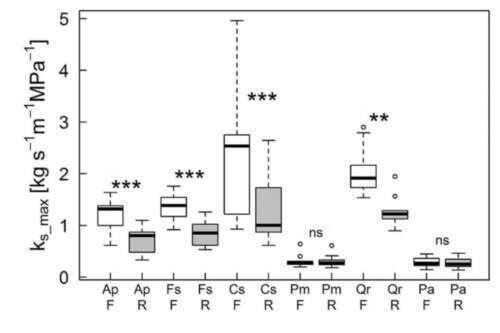
Reduced Reverse Water Flow in Tree Roots in the Context of Hydraulic Redistribution
Climate change will lead to a warmer and drier climate in Central Europe, together with more frequent extreme events. Mixed species forests are expected to have a higher resistance against such climatic challenges. One mechanism behind this might be hydraulic redistribution (HR). Under dry conditions, trees with deeper roots reallocate water from moist to drier soil layers, thus sustaining shallow roots. Limitations of HR, especially the magnitude of reverse water flow in roots (from stems to root tips), are not well understood. We assessed hydraulic conductivities of Acer pseudoplatanus (L.), Fagus sylvatica (L.), Castanea sativa (Mill.), Quercus robur (L.), Pseudotsuga menziesii (Mirb. Franco) and Picea abies (L. Karst.) in both forward and reverse flow direction. Additionally, cross-sections of fine roots were analyzed, to get a better idea of the fine root anatomy and hydraulic structure. While gymnosperms showed no differences, we found a reduction of approx. 30 % in the reverse flow compared to the forward flow in the four angiosperms (figure). We hypothesize that vessel architecture causes this difference, discussing potential effects of asymmetry in vessel wall elements, pit aperture openings and perforation plates.

Figure: Root hydraulic maximum specific conductivity (Ap = A. pseudoplatanus, Fs = F. sylvatica, Cs = C. sativa, Pm = P. menziesii, Qr = Q. robur and Pa = P. abies; F = forward flow (white) and R = reverse flow (grey); asterisks indicate significant differences within one species between forward and reverse flow ***<0.001, **<0.01, ns>0.05).
Powered by Eventact EMS